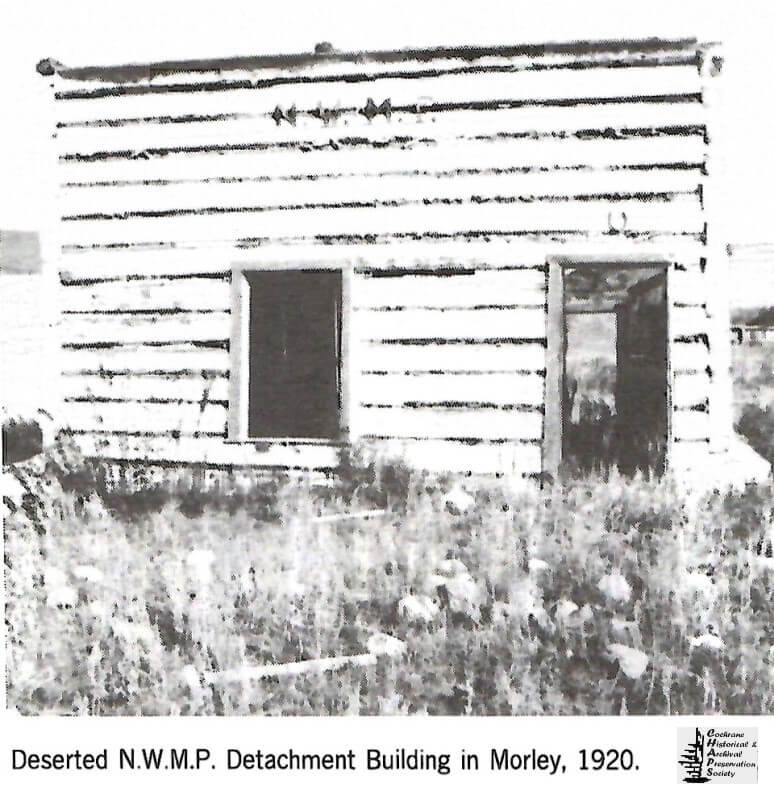This Article was written in 1977 for Big Hill Country. It seems fitting today to include an interpretation of the history of Policing in Canada particularly in our area.
THE MORLEY DETACHMENT OF N.W.M.P. – by Jean L. Johnson
The first connection between the North West Mounted Police and Morleyville came about when Lieutenant-Governor Morris, the first to hold this office in the N.W.T.. requested Rev. George McDougall to proceed on a mission to the Blackfoot and other Indian tribes and explain to them why the Queen was sending a police force to the North West Territories. The McDougalls were very successful in this venture and justified the high opinion in which they were held by both red man and white.
In 1875 the N.W.M.P. had assembled at Tail Creek on the lower crossing of the Red Deer River to await the arrival of General Selby Smyth. One part of the troop was moved to the upper crossing of the Red Deer and ordered to the confluence of the Bow and Elbow Rivers where a fort was to be established. They struck off on a well-marked trail which led them to the Ghost River and on to Morleyville. They then struck east down the Bow River and arrived at the site of their fort. The fact that they were at Morleyville before going on to the chosen location was not an error on their part; this was the regular trail. Other travellers have preferred this route although it was longer than going straight south to Calgary.
On September 22, 1877, the Stoney Indians signed Treaty Number 7, the Chiefs who signed being John Cheneka, Bear’s Paw and Jacob Ki chi-pwot, while among the Stoney Councillors who signed were the familiar names of James Dixon and George Crawler. They received their first treaty payment in 1880. This money was paid out to the Stoney Indians by Inspector Francis Dickens of the N.W.M.P. He was a son of the famous English novelist, Charles Dickens.
The first serious crime from the Morleyville centre occurred in September 1881. Rev. McDougall reported that a large band of horses had been stolen from Morleyville, presumably by Indians from farther south. Investigation showed that the horses had been driven southward towards Fort Macleod, and the word was sent to Supt. Crozier to keep a sharp lookout for them. A small party of N.W.M.P. members was dispatched at once and soon 23 stolen horses were recovered and three Indians arrested. One miscreant turned out to be Jingle Bells who had killed a Cree Indian at the Blackfoot Crossing and had escaped custody at Fort Macleod in the summer of 1880. Another was Marrow Bones, an accomplice of the former and a well-known trouble maker; the third was a youth named The Only-Wood.
When the three were placed on trial for horse stealing they were all found guilty by Magistrate Macleod who was the recently retired N.W.M.P. Commissioner. Jingle Bells was sentenced to three years in Stony Mountain Penitentiary, Manitoba. Marrow Bones drew 18 months in jail at Macleod while The-Only-Wood was given one year.
In 1883 the first actual N.W.M.P. detachment was established at Morleyville. The Post was a log cabin on the north side of the Bow River just north of the Mission down beside Jacob Creek. The main reason for the detachment was the grading and tracking of the C.P.R. as it pushed its way from Calgary. Constant patrolling was kept up along the line with a view to preventing prairie and forest fires. The contractors took little care to keep fires from spreading and much valuable timber was destroyed. Innumerable fires were put out by the Mounties and a large number of arrests made but in most cases, it was impossible to obtain conviction due to lack of evidence.
As the grading went on into the mountains the necessity for further maintaining the detachment at Morleyville disappeared and the non commissioned officers and men from there were moved to the detachment at Padınore, eighteen miles west of Morleyville.
In the distribution sheets for “E” Division, Calgary, in 1888, Morley is shown as a detachment with a strength of two constables and two horses. It is only presumed that when this detachment was re-opened this year, its location was the same as in 1883. There is no definite information on this point. The detachment remained active until 1907, at which time it was closed.
Morley Detachment was re-opened in 1912 with one constable and one horse on strength. The buildings for this Detachment were built on the flat on the south side of the Bow River and the first Mountie there was Constable Barber. On March 1, 1917, the Province of Alberta relieved the Force of police duties and formed the Alberta Provincial Police.
In 1932 the Force absorbed the Alberta Provincial Police and re-opened a detachment in Morley. One corporal and one horse were on strength at the establishment. This posting was lowered to a constable position in 1935. Constable Solway was the last man to patrol from that detachment, mounted. The last R.C.M.P. there was Constable Brian Wright who was in charge of training and handling a Police dog. That was in 1945. In 1946 there were no men at this detachment and only one vehicle on strength. In 1947 the detachment was closed.
In 1935 the old log N.W.M.P. post was moved to Victoria Park in Calgary.
In 1905 the name of the force was changed to Royal North West Mounted Police (R.N.W.M.P.).
In 1920 it became Royal Canadian Mounted Police (R.C.M.P.)

